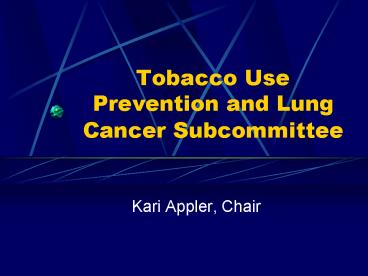Tobacco Use Prevention and Lung Cancer Subcommittee - PowerPoint PPT Presentation
1 / 13
Title:
Tobacco Use Prevention and Lung Cancer Subcommittee
Description:
Michaeline Fedder, MA - American Heart Association. Debra Southerland/Steve Peregoy - American Lung Association ... Lung Cancer Recommendations ... – PowerPoint PPT presentation
Number of Views:95
Avg rating:3.0/5.0
Title: Tobacco Use Prevention and Lung Cancer Subcommittee
1
Tobacco Use Prevention and Lung Cancer
Subcommittee
- Kari Appler, Chair
2
Committee Membership
- Kari Appler (Chairperson) - Smoke Free Maryland
- Christine Crabbs - North Arundel Hospital
- Joan Stine, MS - Office of Health Promotion and
Tobacco Use Prevention - Dawn Berkowitz, MPH - Office of Health Promotion
and Tobacco Use Prevention - Glenn Schneider, MPH - Smoke Free Howard County
- Kathleen Dachille, JD - Center for Tobacco
Regulation, University of Maryland School of Law - Ruth Maiorana - Harford County Health Department
- Mark Breaux - Smoke Free Maryland
- Michaeline Fedder, MA - American Heart
Association - Debra Southerland/Steve Peregoy - American Lung
Association - Albert Blumberg, MD Greater Baltimore Medical
Center - Pat Horton, RN, MBA - Montgomery County Health
Department - Michael Strande, JD - Center for Tobacco
Regulation, University of Maryland School of Law - Sherry McCammon - American Cancer Society
- A. Soula Lambropoulos, MS- Baltimore City Health
Department
3
Youth Smoking Data
- 22 overall youth prevalence rate.
- Race and Ethnicity
- Black 18.6
- Asian 19.7
- Hispanic 23.8
- White 23.8
- Prevalence by grade
- 12th 30.8
- 11th 24.3
- 10th 22.1
- 9th 18.9
- 8th 13.7
- 7th 5.0
4
Adult Smoking Data
Overall Prevalence rate 21.82
- Income
- lt25k 27.5
- 25K 16.4
- By Education
- Not HS Grad 34.3
- HS Grad/GED 24.1
- Some college 18.0
- College Grad 8.9
- Race and Ethnicity
- Black 22.0
- Asian 7.1
- Hispanic 21.2
- White 22.5
- Age
- 18-24 29.5
- 25-34 19.4
- 35-44 18.6
- 45-54 17.3
- 55-64 14.0
- 65 7.2
5
Lung Cancer Data
- Number of cases, 1999 3447
- of all cancer cases 14.8, 4th highest
number of cases. - Number of deaths, 1999 2841
- of all cancer deaths 28.1, highest number
of deaths. - MD lung cancer mortality rate rank in U.S.,
1995-1999 18th highest rate - Males 20th highest
- Females 10th highest.
6
Recommendation Areas
- Data Needs
- Statewide
- Local
- Youth Access
- Cessation
- Smoke Free areas
- Lung Cancer
7
Data Needs
- Collect county specific data and begin
specialized studies in evaluation. - Better/Continued data collection.
- Develop a universal data collection method at the
county level to capture cessation, enforcement,
community and school data and analysis. - Continue funding for a comprehensive CRFP program
evaluation. - Continue comprehensive data collection and
analysis. - Conduct special studies to determine burden of
tobacco in high risk and targeted populations. - Develop user-friendly data reports users.
8
Statewide Recommendations
- Increase tobacco excise tax by an additional
1.50 by 2007. - Continued funding of a CDC-based TUP Program at
CDC minimum levels or above. - Continued support for the Legal Resource Center
located at the University of Maryland Law School.
. - Continued support for the statewide
counter-marketing and media campaign. - Increased collaboration among all statewide TUP
programs including the CRFP.
9
Local Recommendations
- Encourage sharing of county best practices,
information, data, and experiences. - Develop a recognition program for towns/
communities who are implementing a local
comprehensive tobacco control plan. - Provide assistance to counties to implement local
policy (e.g. product placement, smoke free bars
and restaurants.) - Promote increased collaboration between all TUP
programs (including the CRFP) to avoid
duplication of resources and efforts. - Support for local coalitions to pursue public
policy options to reduce tobacco use (e.g.
prevention of youth initiation, promotion of
tobacco cessation.) - Updated state resource directories for tobacco
programs in each county.
10
Youth Access
- Improve enforcement of youth access laws.
- Create local active compliance programs which
provide for civil rather than criminal penalties
and delegate enforcement to an appropriate
agency. - Create a graduated system of penalties,
culminating in license suspension or revocation
for merchants for repeatedly violating sales to
minors law. Merchants and clerks should both be
cited. - Provide education to relevant parts of the
judiciary and business communities. - Enact product placement legislation passed in all
local jurisdictions.
11
Cessation
- Smoking Cessation Quit line
- Promote K-12th grade Tobacco education, as part
of a comprehensive school health education
program. - Increase funding for college-specific tobacco
control intervention programs. - Mandate insurance coverage of smoking cessation
treatment. - Develop a medically delivered cessation program
for pregnant women.
12
Smoke Free Areas
- Establishment of statewide 100 smoke-free school
grounds at all times. - Passage of local and state legislation banning
smoking in all restaurants and bars - Implement education programs on the benefits of
smoke-free homes (i.e. those with small children,
asthmatics). - Ban smoking in ALL FORMS of daycare by closing
the COMAR 07.04.01.33 loophole in the child care
law which only prohibits smoking while "engaged
in care giving activities requiring direct
physical contact...." - Encourage local jurisdictions to pass and enforce
ordinances creating smoke-free public places.
13
Lung Cancer Recommendations
- Allocate significant funding for behavioral
research by Academic Health Centers in Maryland
to develop more effective cessation and
prevention programs across all demographic
groups. - Continue research into tobacco related
malignancies, diagnosis, prevention and
treatment.































